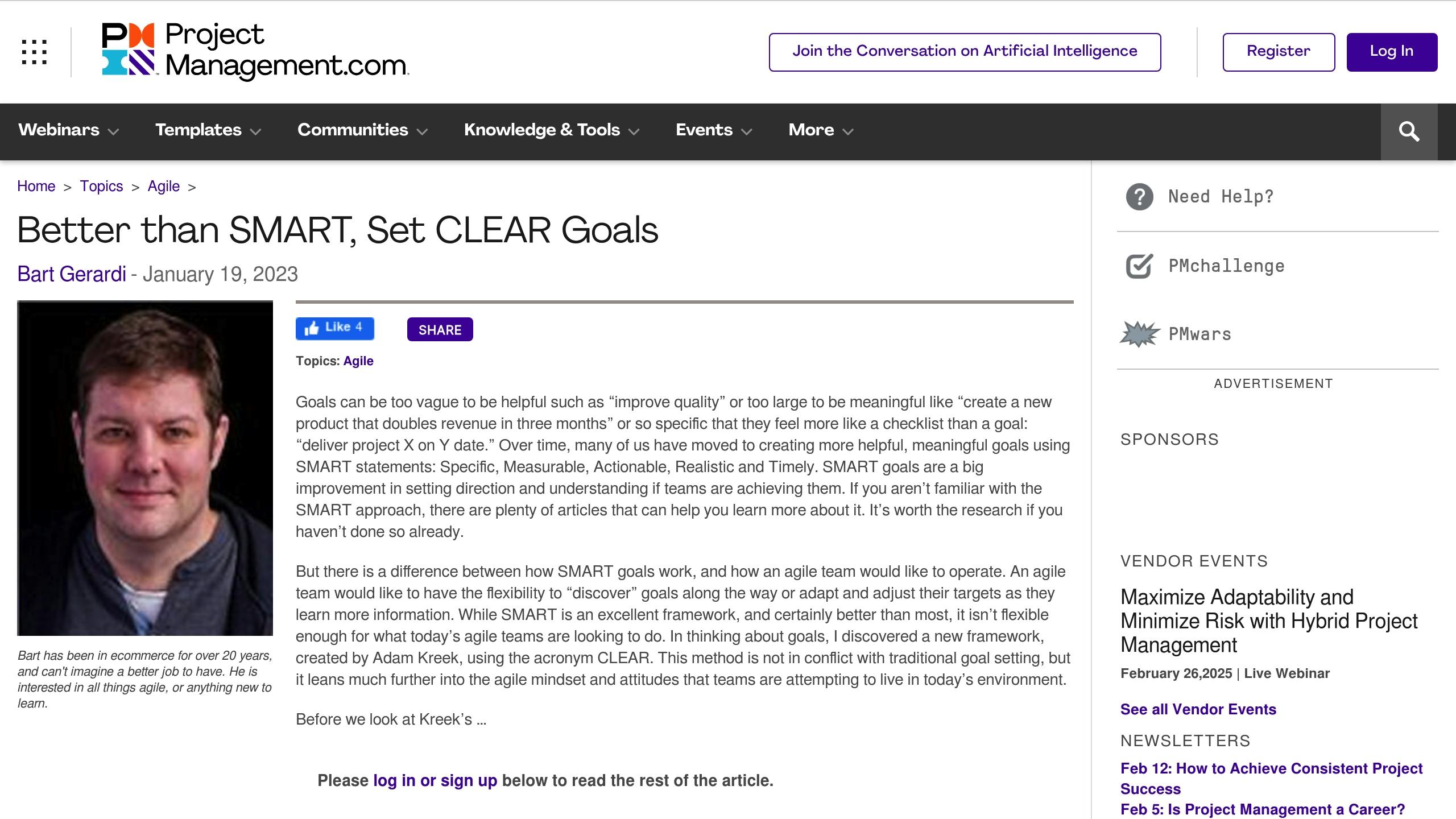The Ultimate Guide to Personal Development: Unlock Your Potential
Explore effective strategies for personal development, from goal setting to building resilience, and unlock your full potential.

Personal development is about improving yourself - building skills, gaining knowledge, and becoming more resilient. Research shows it can reduce stress by 33%, increase life satisfaction by 29%, and boost job promotion rates by 21%. This guide explains how to:
- Know Yourself: Use tools like the "Five Whys" to uncover motivations.
- Set Goals: Choose between SMART (specific, measurable) or CLEAR (flexible, emotional) frameworks.
- Build Better Habits: Small, consistent actions (like reading 2 minutes daily) lead to lasting change.
- Learn from Challenges: Reframe setbacks using methods like the ABCDE model.
- Leverage Tools and Support: Platforms like Upskillist and accountability partners can accelerate growth.
Start today with simple steps like reflecting for 15 minutes, setting one goal, or reaching out to a mentor. Personal growth is a journey of small, consistent improvements. Ready to get started?
Setting SMART Goals - How To Properly Set a Goal
Core Elements of Growth
Personal growth isn't just about ambition - it's about understanding yourself, learning from setbacks, and avoiding common traps along the way. Here's how to focus on three essential building blocks:
Knowing Yourself Better
Self-awareness is the foundation of growth. Tools like the "Five Whys" technique can help you dig deeper into your motivations by asking "why" repeatedly - five times - to uncover the root of your thoughts and actions[1]. Research even shows that those who practice self-reflection are 30% more likely to hit their personal goals[2].
Here are some areas to focus on:
| Area of Focus | Key Questions | Practice to Try |
|---|---|---|
| Values | What truly matters to you? | Take a values assessment |
| Strengths | What activities make you feel energized? | Complete a VIA Survey |
| Growth Areas | Where do you often face challenges? | Schedule regular feedback sessions |
Learning from Challenges
Challenges are inevitable, but reframing how you see them can make all the difference. The ABCDE model breaks this process into manageable steps: identify the Adversity, examine your Beliefs, look at the Consequences, Dispute unhelpful thoughts, and Energize yourself with new actions[3]. Psychologist Martin Seligman has shown that using this framework can boost resilience and problem-solving abilities.
Common Mistakes to Avoid
Practicing self-compassion can increase your chances of success by 43%[4]. But it’s easy to fall into these traps:
- Perfectionism: Focus on making progress, not being perfect.
- Comparison: Measure your growth against your own milestones, not someone else’s.
- Imbalanced Learning: Follow the 70-20-10 rule: learn mostly through experience (70%), gain insights from others (20%), and rely on formal education (10%)[1].
Finally, the "1% Rule" reminds us that small, consistent improvements add up over time[5]. This approach, reflected in Upskillist's practical and incremental courses, shows the power of steady growth.
Goal Setting That Works
Now that we've tackled common growth barriers, let's dive into how to set goals that actually lead to success. Did you know that people who write down their goals are 42% more likely to achieve them? [1]. That’s a big deal when it comes to personal development.
Choosing Between SMART and CLEAR Goals

Picking the right goal-setting framework is a game-changer. Two popular methods - SMART and CLEAR - offer different approaches depending on your needs. Here's a quick comparison:
| Framework | Best For | Key Components | Example |
|---|---|---|---|
| SMART | Specific achievements | Specific, Measurable, Achievable, Relevant, Time-bound | Learn Spanish to B1 level in 6 months |
| CLEAR | Continuous improvement | Collaborative, Limited, Emotional, Refinable | Improve communication skills through weekly practice |
SMART goals are ideal for measurable outcomes like learning a new skill, while CLEAR goals fit situations where emotional involvement and flexibility are key. Use SMART for clearly defined milestones and CLEAR when growth requires adaptability.
Building Better Habits
Forget the old myth that habits form in 21 days. Research shows it actually takes 66 days to build lasting habits [7]. Here's how you can make that process smoother:
- Start Small: Begin with tiny, manageable changes. For instance, if you want to read more, place a book next to your coffee mug and read for just two minutes each morning. This creates a "habit loop" with clear triggers and rewards.
- Digital tools like apps to boost motivation can provide timely reminders, progress tracking, and reward systems that reinforce your habit-building efforts and help overcome the initial resistance to change.
-
Habit Stacking: Combine new habits with existing routines to make them stick. For example:
- After brushing your teeth: meditate for 5 minutes.
- After lunch: review your goals for 2 minutes.
- Before bed: write one paragraph in a journal.
These small, consistent actions build momentum over time, aligning with the idea of improving just 1% every day.
Using Online Learning Platforms
Online learning is booming, with the market hitting $315.10 billion in 2021 [8]. These platforms are great tools for personal growth, thanks to their structured approach to learning. They often incorporate the 70-20-10 rule, offering:
- Courses tailored to your goals
- Flexible, self-paced options
- Practical skill-building exercises
- Tools to track your progress
If you’re serious about growth, these platforms can help you stay on track while fitting learning into your schedule.
Skills and Mental Strength
Achieving goals effectively requires both technical know-how and mental toughness. According to LinkedIn's 2019 Global Talent Trends report, 80% of professionals believe soft skills are crucial for company success [1].
Hard and Soft Skills
Hard skills (technical abilities) and soft skills (interpersonal traits) work together to drive personal and professional growth. As LinkedIn data highlights, soft skills are a priority for 80% of professionals aiming for career advancement [1].
| Skill Type | Examples | How to Develop Them |
|---|---|---|
| Hard Skills | Data analysis, coding, languages | Online courses, certifications, projects |
| Soft Skills | Communication, leadership, teamwork | Role-playing, group activities, practice |
Take a data analyst as an example. They might focus on refining analysis techniques while also collaborating on team projects and enrolling in courses. Platforms like Upskillist provide training that combines both hard and soft skill development [3].
Navigating Challenges
Mental resilience goes beyond simply enduring tough situations. The American Psychological Association reports that 65% of adults identify work as a major source of stress [6].
-
Reframing Challenges
- Adversity: Pinpoint the specific challenge.
- Beliefs: Reflect on your thoughts about it.
- Consequences: Assess how these thoughts influence your actions.
- Dispute: Counter negative thinking patterns.
- Energize: Focus on actionable, positive steps.
-
Building Resilience with Routine
- Practice mindfulness daily.
- Track your progress regularly.
- Lean on peer support when needed.
- Take purposeful recovery breaks.
Setbacks are part of the process - they offer learning opportunities rather than signaling failure. Research underscores that resilience is a skill you can develop with consistent effort [6].
To protect your mental energy while developing new skills, integrate these habits into your routine:
- Set achievable daily goals.
- Schedule regular breaks.
- Show yourself kindness during tough moments.
- Surround yourself with supportive mentors and peers.
These practices complement habit-stacking strategies, helping you stay balanced while pushing forward.
People and Tools for Growth
Building a strong support network can significantly boost your ability to achieve goals. Research shows that having an accountability partner can raise goal completion rates from 65% to 95% when regular check-ins are part of the process[1]. This kind of external support works hand-in-hand with mental resilience strategies by adding an extra layer of motivation and structure.
Creating Your Support System
An effective support system includes a mix of key roles that contribute to your growth:
| Role | Purpose | How to Find Them |
|---|---|---|
| Mentors | Offer professional advice and industry knowledge | Attend industry events, connect on LinkedIn, or tap into alumni networks |
| Cheerleaders | Provide emotional backing and encouragement | Reach out to friends, family, or supportive colleagues |
| Subject Matter Experts | Share technical expertise and help build skills | Join professional groups or engage in online communities |
According to the Journal of Applied Psychology, showing gratitude strengthens these relationships, fostering even more supportive interactions within your network[2]. Make it a habit to acknowledge and appreciate the efforts of those in your circle.
Picking Learning Resources
Choosing the right learning resources is all about balancing quality and practicality. This ties back to the 70-20-10 learning model discussed earlier, ensuring you can apply what you learn in real-world scenarios.
What to Look for in Learning Resources:
- Credibility: Focus on material created by experts with proven success.
- Format Fit: Pick resources that match your preferred way of learning.
- Time Commitment: Make sure the resource fits into your schedule.
- Return on Investment: Assess whether the effort and cost are worth the benefits.
- Hands-On Practice: Opt for resources that include opportunities to apply what you learn.
Platforms like Upskillist are a great example, offering expert-led courses designed for immediate skill application. Combine structured learning with real-world practice to maximize your growth.
Next Steps
Now that you have your support network and learning tools ready, it’s time to put them into action. Here's how you can turn your self-awareness and learning insights into measurable progress.
Steps to Take Today
Kickstart your personal growth with these practical actions:
| Action | Time Required | Expected Outcome |
|---|---|---|
| Reflection (15 minutes) | 15 minutes | Gain clarity on goals and improve self-awareness. |
| Goal Setting Session | 30 minutes | Define one SMART goal and create an action plan. |
| Skill Gap Analysis | 20 minutes | Identify learning priorities. |
| Build Support Network | 45 minutes | Reach out to two potential mentors or accountability partners. |
Incorporate a morning routine that aligns with your personal development objectives. This could include journaling, meditation, or reviewing your action plan.
Moving Forward
Once you’ve laid the groundwork, focus on maintaining and refining your habits to ensure consistent growth.
Daily Growth Rituals
- Track your progress every day to stay motivated and accountable.
Weekly Check-ins
Use measurable metrics to evaluate your progress weekly. Research shows that people who regularly track their development are 76% more likely to stick to their personal growth goals [7].
Quarterly Reassessment
Every 90 days, review your goals and adjust them based on your progress. This approach, used by high achievers, ensures you stay on track [8]. Additionally, keep a "wins journal" to celebrate small victories. Recognizing even minor achievements has been shown to boost the chances of reaching bigger goals by 44% [3].
FAQs
What are the 5 components of a personal development plan?
A personal development plan focuses on five main elements to guide personal growth effectively:
| Component | Key Action |
|---|---|
| Self-assessment | Use tools like Five Whys or VIA |
| Goal setting | Follow SMART or CLEAR frameworks |
| Action planning | Set weekly milestones |
| Resources | Gather support and materials |
| Progress tracking | Conduct daily check-ins |
This method aligns well with the 70-20-10 learning model mentioned earlier [1].
What habit contributes to self-improvement?
Certain daily practices can significantly enhance personal growth when paired with techniques like habit-stacking or the 1% Rule:
- Read for at least 10 minutes daily to build skills.
- Write in a reflective journal to process thoughts and progress.
- Practice short mindfulness exercises to stay focused.




